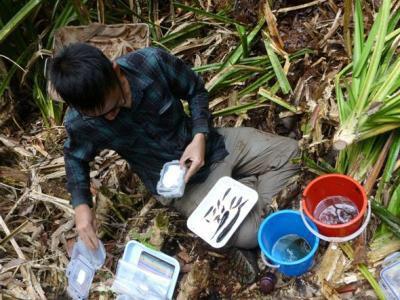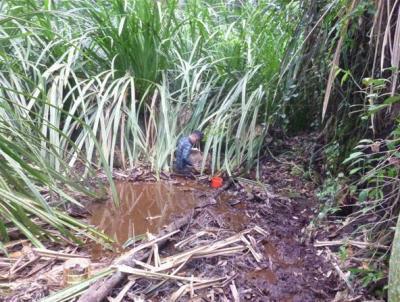Xingli Giam
This project aims to elucidate the impact of plantation agriculture on the blackwater fishes of Southeast Asia, as well as, understand how environmental factors structure fish communities across peat swamp landscapes in Southeast Asia.

Processing fish samples in the field. Fish caught had to be euthanised using a chemical agent (MS222) approved by the university ethics board.
Peat swamp forests in Southeast Asia are one of the most unique, but at the same time, one of the most critically imperilled ecosystems on Earth. Despite being rich in fish species — many of which are strict endemics found nowhere else — Southeast Asian peat swamp forests are being lost at unprecedented rates. While previous studies have surveyed the fish communities in the peat swamps of Peninsular Malaysia and Sarawak, the ecology of peat swamp fishes with respect to their spatial species richness patterns, community structure, and response to habitat degradation remains unknown. In this study, we hope to fill these knowledge gaps by studying fish communities across different land use types across lotic streams of peat swamp forest (commonly known as blackwaters) in Riau Province, Sumatra, Indonesia. First, we will evaluate the impacts of plantation conversion on blackwater fish communities. Second, we aim to elucidate the environmental factors that structure fish communities in intact peat swamp forests as well as across different land-use types on peatlands.

Processing fish samples from a pool site in Stage 2-3 PSF.
To address these questions, we will sample fish using a variety of non-destructive methods that include tray-netting, seining, and cast-netting, in blackwater streams in relatively intact forests and Acacia monoculture plantations in the Kampar Peninsula and Kerumutan Wildlife Reserve in Riau Province, Sumatra, Indonesia. Fifteen to twenty-five sampling sites will be randomly assigned in each of the three habitat types: streams in intact peat swamp forest, streams in plantations, and canals in plantations. Local habitat and water physicochemical parameters such as canopy cover, water temperature, dissolved oxygen content, tannin concentration, will be recorded in situ. Landscape variables such as the proportion of high conservation value forest (HCVF) surrounding each sampling site, and nearest distance from intact forest, will be recorded from GIS maps obtained from satellite imagery and plantation companies. Both local and landscape environmental variables will be used as explanatory variables to explain fish species richness and composition. Generalized linear models will be built and analysed under a multimodal inference framework to identify the models that best predict the observed species richness patterns. Canonical correspondence analysis will be used to test whether environmental factors structure fish communities in peat swamp blackwaters.
Our study represents the first attempt to understand the impacts of land use change on the unique fish biodiversity of peat swamp forests and elucidate how fish communities are structured across different stages of a peat swamp forest. Overall, by advancing the hitherto limited ecological and conservation knowledge of peat swamp forests, our study will contribute toward the continued preservation of this highly imperilled habitat and its unique ichthyofauna.